- GCN NOTICE
TITLE: GCN/SWIFT NOTICE
NOTICE_DATE: Fri 28 Apr 17 09:13:56 UT
NOTICE_TYPE: Swift-BAT GRB Position
TRIGGER_NUM: 750298, Seg_Num: 0
GRB_RA: 330.063d {+22h 00m 15s} (J2000),
330.260d {+22h 01m 02s} (current),
329.493d {+21h 57m 58s} (1950)
GRB_DEC: +26.918d {+26d 55' 03"} (J2000),
+27.001d {+27d 00' 04"} (current),
+26.677d {+26d 40' 37"} (1950)
GRB_ERROR: 3.00 [arcmin radius, statistical only]
GRB_INTEN: 1726 [cnts] Image_Peak=183 [image_cnts]
TRIGGER_DUR: 0.064 [sec]
TRIGGER_INDEX: 10427 E_range: 50-350 keV
BKG_INTEN: 27162 [cnts]
BKG_TIME: 33213.02 SOD {09:13:33.02} UT
BKG_DUR: 8 [sec]
GRB_DATE: 17871 TJD; 118 DOY; 17/04/28
GRB_TIME: 33222.30 SOD {09:13:42.30} UT
GRB_PHI: 165.76 [deg]
GRB_THETA: 33.01 [deg]
SOLN_STATUS: 0x3
RATE_SIGNIF: 96.35 [sigma]
IMAGE_SIGNIF: 12.87 [sigma]
MERIT_PARAMS: +1 +0 +0 -4 +3 +2 +0 +0 -46 +0
SUN_POSTN: 35.91d {+02h 23m 38s} +14.26d {+14d 15' 54"}
SUN_DIST: 62.10 [deg] Sun_angle= 4.4 [hr] (West of Sun)
MOON_POSTN: 63.81d {+04h 15m 14s} +16.17d {+16d 09' 58"}
MOON_DIST: 85.79 [deg]
MOON_ILLUM: 5 [%]
GAL_COORDS: 82.11,-22.08 [deg] galactic lon,lat of the burst (or transient)
ECL_COORDS: 343.55, 36.32 [deg] ecliptic lon,lat of the burst (or transient)
COMMENTS: SWIFT-BAT GRB Coordinates.
COMMENTS: This is a rate trigger.
COMMENTS: A point_source was found.
COMMENTS: This does not match any source in the on-board catalog.
COMMENTS: This does not match any source in the ground catalog.
COMMENTS: This is a GRB.
COMMENTS: This trigger occurred at longitude,latitude = 344.83,-12.83 [deg].
- GCN NOTICE
TITLE: GCN/SWIFT NOTICE
NOTICE_DATE: Fri 28 Apr 17 09:15:39 UT
NOTICE_TYPE: Swift-XRT Nack-Position
TRIGGER_NUM: 750298, Seg_Num: 0
POINT_RA: 330.059d {+22h 00m 14s} (J2000)
POINT_DEC: +26.915d {+26d 54' 52"} (J2000)
IMG_START_DATE: 17871 TJD; 118 DOY; 17/04/28
IMG_START_TIME: 33306.93 SOD {09:15:06.93} UT, 84.6 [sec] since BAT Trigger Time
COUNTS: 4 Min_needed= 20
STD_DEV: 0.00 Max_StdDev_for_Good=28.44 [arcsec]
PH2_ITER: 1 Max_iter_allowed= 4
ERROR_CODE: 1
COMMENTS: SWIFT-XRT Nack Position.
COMMENTS: No source found in the image.
- GCN NOTICE
TITLE: GCN/SWIFT NOTICE
NOTICE_DATE: Fri 28 Apr 17 09:17:37 UT
NOTICE_TYPE: Swift-BAT GRB Lightcurve
TRIGGER_NUM: 750298, Seg_Num: 0
GRB_RA: 330.063d {+22h 00m 15s} (J2000),
330.260d {+22h 01m 02s} (current),
329.493d {+21h 57m 58s} (1950)
GRB_DEC: +26.918d {+26d 55' 03"} (J2000),
+27.001d {+27d 00' 04"} (current),
+26.677d {+26d 40' 37"} (1950)
GRB_DATE: 17871 TJD; 118 DOY; 17/04/28
GRB_TIME: 33222.45 SOD {09:13:42.45} UT
TRIGGER_INDEX: 10427
GRB_PHI: 165.76 [deg]
GRB_THETA: 33.01 [deg]
DELTA_TIME: 16.00 [sec]
TRIGGER_DUR: 0.064 [sec]
SOLN_STATUS: 0x3
RATE_SIGNIF: 96.35 [sigma]
IMAGE_SIGNIF: 12.87 [sigma]
LC_URL: sw00750298000msb.lc
SUN_POSTN: 35.91d {+02h 23m 38s} +14.27d {+14d 15' 56"}
SUN_DIST: 62.10 [deg] Sun_angle= 4.4 [hr] (West of Sun)
MOON_POSTN: 63.85d {+04h 15m 24s} +16.17d {+16d 10' 23"}
MOON_DIST: 85.82 [deg]
MOON_ILLUM: 5 [%]
GAL_COORDS: 82.11,-22.08 [deg] galactic lon,lat of the burst (or transient)
ECL_COORDS: 343.55, 36.32 [deg] ecliptic lon,lat of the burst (or transient)
COMMENTS: SWIFT-BAT GRB Lightcurve.
COMMENTS:
COMMENTS: The next comments were copied from the BAT_POS Notice:
COMMENTS: This is a rate trigger.
COMMENTS: A point_source was found.
COMMENTS: This does not match any source in the on-board catalog.
COMMENTS: This does not match any source in the ground catalog.
COMMENTS: This is a GRB.
COMMENTS: This trigger occurred at longitude,latitude = 344.83,-12.83 [deg].
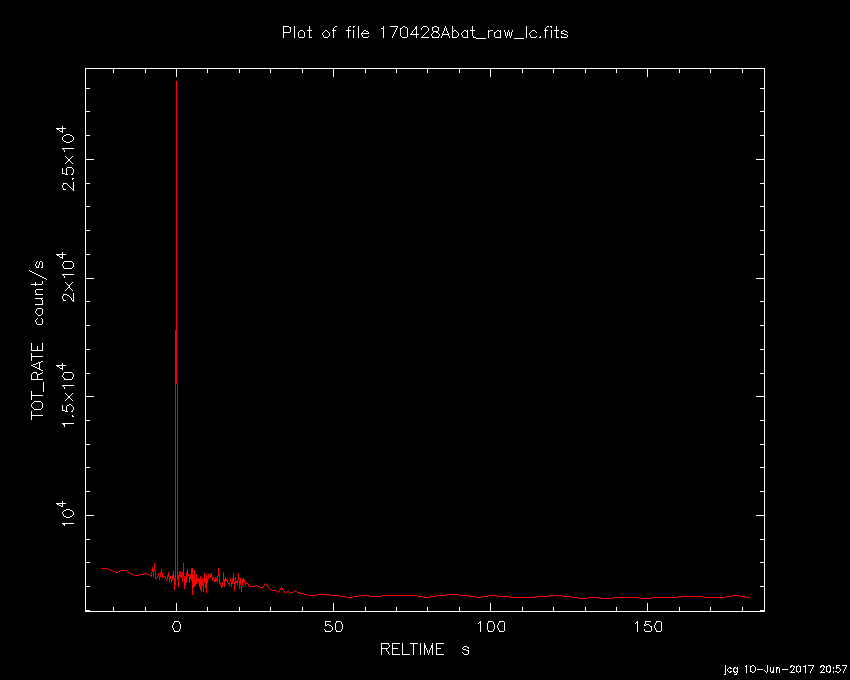
- GCN NOTICE
TITLE: GCN/SWIFT NOTICE
NOTICE_DATE: Fri 28 Apr 17 09:29:58 UT
NOTICE_TYPE: Swift-UVOT Source List
TRIGGER_NUM: 750298, Seg_Num: 0
POINT_RA: 330.060d {+22h 00m 14s} (J2000)
POINT_DEC: +26.913d {+26d 54' 47"} (J2000)
POINT_ROLL: 87.399d
IMG_START_DATE: 17871 TJD; 118 DOY; 17/04/28
IMG_START_TIME: 34088.32 SOD {09:28:08.32} UT, 866.0 [sec] since BAT Trigger Time
FILTER: 7, U
BKG_MEAN: 1.184
N_STARS: 78
X_OFFSET: 239 [pixels]
Y_OFFSET: 276 [pixels]
X_MAX: 1678 [pixels]
Y_MAX: 1715 [pixels]
DET_THRESH: 9
PHOTO_THRESH: 4
SL_URL: sw00750298000msufc0866.fits
SUN_POSTN: 35.92d {+02h 23m 40s} +14.27d {+14d 16' 06"}
SUN_DIST: 62.11 [deg] Sun_angle= 4.4 [hr] (West of Sun)
MOON_POSTN: 63.98d {+04h 15m 55s} +16.20d {+16d 11' 46"}
MOON_DIST: 85.93 [deg]
MOON_ILLUM: 5 [%]
GAL_COORDS: 82.10,-22.08 [deg] galactic lon,lat of the pointing direction
ECL_COORDS: 343.54, 36.32 [deg] ecliptic lon,lat of the pointing direction
COMMENTS: SWIFT-UVOT Source List.
- GCN NOTICE
TITLE: GCN/SWIFT NOTICE
NOTICE_DATE: Fri 28 Apr 17 09:30:26 UT
NOTICE_TYPE: Swift-UVOT Processed Source List
TRIGGER_NUM: 750298, Seg_Num: 0
POINT_RA: 330.060d {+22h 00m 14s} (J2000)
POINT_DEC: +26.913d {+26d 54' 47"} (J2000)
POINT_ROLL: 87.399d
IMG_START_DATE: 17871 TJD; 118 DOY; 17/04/28
IMG_START_TIME: 34088.32 SOD {09:28:08.32} UT, 866.0 [sec] since BAT Trigger Time
FILTER: 7, U
BKG_MEAN: 1.184
N_STARS: 78
X_OFFSET: 239 [pixels]
Y_OFFSET: 276 [pixels]
X_MAX: 1678 [pixels]
Y_MAX: 1715 [pixels]
DET_THRESH: 9
PHOTO_THRESH: 4
SL_URL: sw00750298000msufc0866.fits
SUN_POSTN: 35.92d {+02h 23m 40s} +14.27d {+14d 16' 06"}
SUN_DIST: 62.11 [deg] Sun_angle= 4.4 [hr] (West of Sun)
MOON_POSTN: 63.98d {+04h 15m 56s} +16.20d {+16d 11' 49"}
MOON_DIST: 85.93 [deg]
MOON_ILLUM: 5 [%]
GAL_COORDS: 82.10,-22.08 [deg] galactic lon,lat of the pointing direction
ECL_COORDS: 343.54, 36.32 [deg] ecliptic lon,lat of the pointing direction
COMMENTS: SWIFT-UVOT Processed Source List.
COMMENTS: All 4 attachments are included.
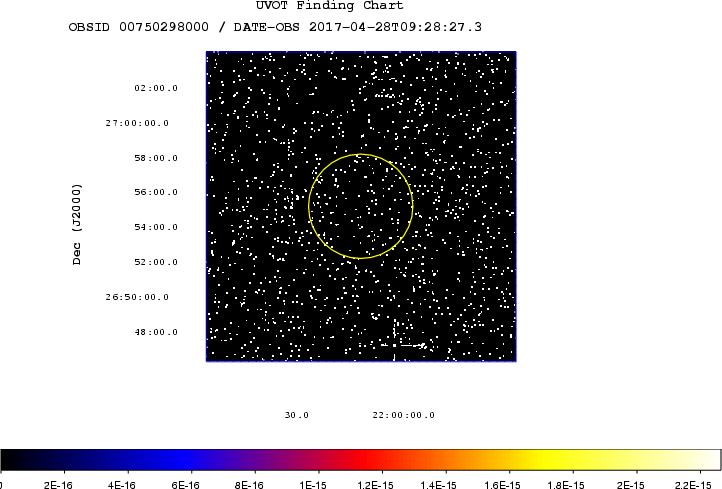
- GCN NOTICE
TITLE: GCN/SWIFT NOTICE
NOTICE_DATE: Fri 28 Apr 17 09:31:49 UT
NOTICE_TYPE: Swift-UVOT Image
TRIGGER_NUM: 750298, Seg_Num: 0
POINT_RA: 330.060d {+22h 00m 14s} (J2000)
POINT_DEC: +26.913d {+26d 54' 47"} (J2000)
ROLL: 87.399d
IMG_START_DATE: 17871 TJD; 118 DOY; 17/04/28
IMG_START_TIME: 34088.32 SOD {09:28:08.32} UT, 866.0 [sec] since BAT Trigger Time
FILTER: 7, U
EXPOSURE_ID: 515064507
X_OFFSET: 798 [pixels]
Y_OFFSET: 835 [pixels]
WIDTH: 160 [pixels]
HEIGHT: 160 [pixels]
X_GRB_POS: 958
Y_GRB_POS: 995
BINNING_INDEX: 1
IM_URL: sw00750298000msuni0885.fits
SUN_POSTN: 35.92d {+02h 23m 41s} +14.27d {+14d 16' 08"}
SUN_DIST: 62.11 [deg] Sun_angle= 4.4 [hr] (West of Sun)
MOON_POSTN: 64.00d {+04h 16m 00s} +16.20d {+16d 11' 58"}
MOON_DIST: 85.94 [deg]
MOON_ILLUM: 5 [%]
GAL_COORDS: 82.10,-22.08 [deg] galactic lon,lat of the pointing direction
ECL_COORDS: 343.54, 36.32 [deg] ecliptic lon,lat of the pointing direction
COMMENTS: SWIFT-UVOT Image.
COMMENTS: The GRB Position came from the Window Position in the Mode Command.
COMMENTS: The image has 2x2 binning (compression).
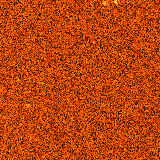
- GCN NOTICE
TITLE: GCN/SWIFT NOTICE
NOTICE_DATE: Fri 28 Apr 17 09:32:08 UT
NOTICE_TYPE: Swift-UVOT Processed Image
TRIGGER_NUM: 750298, Seg_Num: 0
POINT_RA: 330.060d {+22h 00m 14s} (J2000)
POINT_DEC: +26.913d {+26d 54' 47"} (J2000)
ROLL: 87.399d
IMG_START_DATE: 17871 TJD; 118 DOY; 17/04/28
IMG_START_TIME: 34088.32 SOD {09:28:08.32} UT, 866.0 [sec] since BAT Trigger Time
FILTER: 7, U
EXPOSURE_ID: 515064507
X_OFFSET: 798 [pixels]
Y_OFFSET: 835 [pixels]
WIDTH: 160 [pixels]
HEIGHT: 160 [pixels]
X_GRB_POS: 958
Y_GRB_POS: 995
BINNING_INDEX: 1
IM_URL: sw00750298000msuni0885.fits
SUN_POSTN: 35.92d {+02h 23m 41s} +14.27d {+14d 16' 08"}
SUN_DIST: 62.11 [deg] Sun_angle= 4.4 [hr] (West of Sun)
MOON_POSTN: 64.00d {+04h 16m 01s} +16.20d {+16d 12' 00"}
MOON_DIST: 85.94 [deg]
MOON_ILLUM: 5 [%]
GAL_COORDS: 82.10,-22.08 [deg] galactic lon,lat of the pointing direction
ECL_COORDS: 343.54, 36.32 [deg] ecliptic lon,lat of the pointing direction
COMMENTS: SWIFT-UVOT Processed Image.
COMMENTS: The GRB Position came from the Window Position in the Mode Command.
COMMENTS: The image has 2x2 binning (compression).
COMMENTS: All 4 attachments are included.
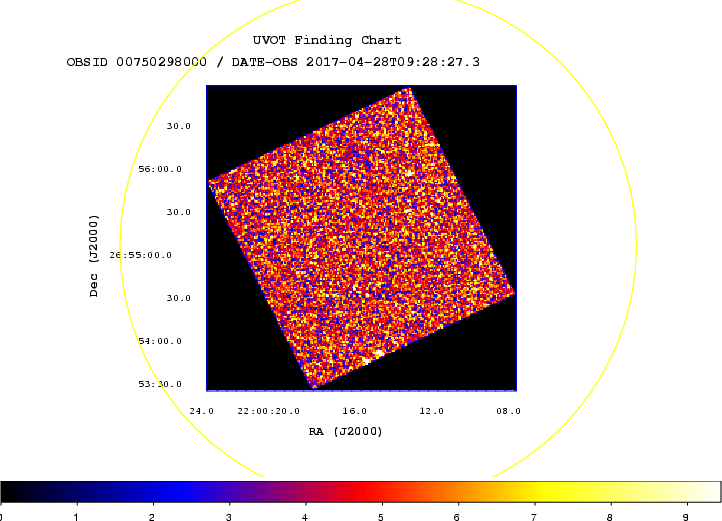
- GCN Circular #21042
A. P. Beardmore (U Leicester), N. P. M. Kuin (UCL-MSSL),
K. L. Page (U Leicester), D. M. Palmer (LANL),
B. Sbarufatti (INAF-OAB/PSU) and R. L. C. Starling (U Leicester)
report on behalf of the Swift Team:
At 09:13:42 UT, the Swift Burst Alert Telescope (BAT) triggered and
located GRB 170428A (trigger=750298). Swift slewed immediately to the burst.
The BAT on-board calculated location is
RA, Dec 330.063, +26.918 which is
RA(J2000) = 22h 00m 15s
Dec(J2000) = +26d 55' 03"
with an uncertainty of 3 arcmin (radius, 90% containment, including
systematic uncertainty). The BAT light curve showed a single peak
structure with a duration of about 0.25 sec. The peak count rate
was ~22000 counts/sec (15-350 keV), at ~0 sec after the trigger.
The XRT began observing the field at 09:15:06.9 UT, 84.6 seconds after
the BAT trigger. Swift then passed into the SAA, during which time no
data are collected. No source was detected in 208 s of promptly downlinked
data. We are waiting for the full dataset to detect and localise the
XRT counterpart.
UVOT took a finding chart exposure of 84 seconds with the U filter starting
866 seconds after the BAT trigger. No credible afterglow candidate has been
found in the initial data products. The 2.7'x2.7' sub-image covers 25% of the
BAT error circle. The typical 3-sigma upper limit has been about 19.2 mag. The
8'x8' region for the list of sources generated on-board covers 100% of the BAT
error circle. The list of sources is typically complete to about 18.0 mag. No
correction has been made for the expected extinction corresponding to E(B-V) of
0.06.
Burst Advocate for this burst is A. P. Beardmore (apb AT star.le.ac.uk).
Please contact the BA by email if you require additional information
regarding Swift followup of this burst. In extremely urgent cases, after
trying the Burst Advocate, you can contact the Swift PI by phone (see
Swift TOO web site for information: http://www.swift.psu.edu/too.html.)
- GCN Circular #21045
A. Tsvetkova, S. Golenetskii, R. Aptekar, D. Frederiks, D. Svinkin,
P. Oleynik, M. Ulanov, A. Lysenko, A.Kozlova, and T. Cline
on behalf of the Konus-Wind team, report:
The short-duration, bright GRB 170428A
(Swift-BAT detection: Beardmore et al., GCN Circ. 21042)
triggered Konus-Wind at T0=33218.719 s UT (09:13:38.719).
The burst light curve shows a multipeaked structure
which starts at ~T0-0.02 s and has a total duration of ~0.14 s.
The emission is seen up to ~10 MeV.
The Konus-Wind light curve of this GRB is available at
http://www.ioffe.ru/LEA/GRBs/GRB170428_T33218/
As observed by Konus-Wind, the burst
had a fluence of 4.20(-0.90,+0.91)x10^-6 erg/cm2,
and a 16-ms peak flux, measured from T0+0.056 s,
of 5.00(-1.52,+1.53)x10^-5 erg/cm2/s
(both in the 20 keV - 10 MeV energy range).
The time-averaged spectrum of the burst
(measured from T0 to T0+0.128 s)
is best fit in the 20 keV - 10 MeV range
by the GRB (Band) model with the following parameters:
the low-energy photon index alpha = -0.47(-0.21,+0.28),
the high energy photon index beta = -2.46(-7.54,+0.52),
the peak energy Ep = 982(-355,+394) keV (chi2 = 31/37 dof).
Fitting this spectrum by a power law with exponential cutoff model
dN/dE ~ (E^alpha)*exp(-E*(2+alpha)/Ep) yields
alpha = -0.53(-0.18,+0.21) and
Ep = 1134(-268,+368) keV (chi2 = 33/38 dof).
All the quoted errors are at the 90% confidence level.
All the quoted values are preliminary.
- GCN Circular #21046
S. D. Barthelmy (GSFC), A. P. Beardmore (U Leicester), J. R. Cummings (CPI),
H. A. Krimm (NSF/USRA), A. Y. Lien (GSFC/UMBC), C. B. Markwardt (GSFC),
D. M. Palmer (LANL), T. Sakamoto (AGU), M. Stamatikos (OSU),
T. N. Ukwatta (LANL) (i.e. the Swift-BAT team):
Using the data set from T-119 to T+303 sec from the recent telemetry downlink,
we report further analysis of BAT GRB 170428A (trigger #750298)
(Beardmore, et al., GCN Circ. 21042). The BAT ground-calculated position is
RA, Dec = 330.051, 26.913 deg which is
RA(J2000) = 22h 00m 12.3s
Dec(J2000) = +26d 54' 47.9"
with an uncertainty of 1.2 arcmin, (radius, sys+stat, 90% containment).
The partial coding was 62%.
The mask-weighted light curve shows a complex of three peaks within a period
from T+0.15 to T+0.35 sec. There is no sign of extended emission.
T90 (15-350 keV) is 0.20 +- 0.07 sec (estimated error including systematics).
The time-averaged spectrum from T+0.15 to T+0.45 sec is best fit by a simple
power-law model. The power law index of the time-averaged spectrum is
0.76 +- 0.12. The fluence in the 15-150 keV band is 2.8 +- 0.2 x 10^-7 erg/cm2.
The 1-sec peak photon flux measured from T-0.20 sec in the 15-150 keV band
is 2.8 +- 0.2 ph/cm2/sec. All the quoted errors are at the 90% confidence
level.
The results of the batgrbproduct analysis are available at
http://gcn.gsfc.nasa.gov/notices_s/750298/BA/
- GCN Circular #21047
A.P. Beardmore and P.A. Evans (U. Leicester) report on behalf of the
Swift-XRT team:
We have analysed 4.2 ks of XRT data for GRB 170428A, from 697 s to 17.2
ks after the BAT trigger. The data are entirely in Photon Counting
(PC) mode. Using 1475 s of PC mode data and 2 UVOT images, we find an
enhanced XRT position (using the XRT-UVOT alignment and matching UVOT
field sources to the USNO-B1 catalogue): RA, Dec = 330.07813, +26.91580
which is equivalent to:
RA (J2000): 22h 00m 18.75s
Dec(J2000): +26d 54' 56.9"
with an uncertainty of 2.3 arcsec (radius, 90% confidence).
The light curve can be modelled with a power-law decay with a decay
index of alpha=1.03 (+0.32, -0.29).
If the light curve continues to decay with a power-law decay index of
1.03, the count rate at T+24 hours will be 7.5 x 10^-4 count s^-1
The results of the XRT-team automatic analysis are available at
http://www.swift.ac.uk/xrt_products/00750298.
This circular is an official product of the Swift-XRT team.
- GCN Circular #21048
D. Xu (NAOC), Y. Qin (Geneva Obs.), Y. Zhao, J.J. Jia, H.X. Feng, Z.P.
Zhu (NAOC), Y.D. Hu (IAA-CSIC), S. Feng, M.T. Ju (SHAO) report
We observed the field of short GRB 170428A (Beardmore et al., GCN 21042)
using the 2.16-m telescope located at Xinglong, Hebei, China. We
obtained 6x300s R-band frames, starting at 19:23:21 UT on 2017-04-28
(i.e., 10.16 hr after the burst).
No optical source is detected at the XRT position (Beardmore & Evans,
GCN 21047) in the stacked R-band image, down to a limiting magnitude of
m(R)>21.0.
We note that in the SDSS and Pan-STARRS archival data there already
exists a singe source within the XRT error circle, seemingly extended in
the northeast - southwest direction. It is localised at
R.A (J2000) = 22:00:18.687
Dec. (J2000) = +26:54:56.51
with a brightness of m(r)~22.2 mag, and thus might be the host galaxy of
this short burst.
- GCN Circular #21049
N. P. M. Kuin (UCL-MSSL) and A. P. Beardmore (U. Leicester) report
on behalf of the Swift/UVOT team:
The Swift/UVOT began settled observations of the field of GRB 170428A
740 s after the BAT trigger (Beardmore et al., GCN Circ. 21042).
No optical afterglow consistent with the XRT position (Beardmore
et al., GCN Circ. 21047) is detected in the initial UVOT exposures.
Preliminary 3-sigma upper limits using the UVOT photometric system
(Breeveld et al. 2011, AIP Conf. Proc. 1358, 373) for the initial exposures
are:
Filter T_start(s) T_stop(s) Exp(s) Mag
v 740 16576 1101 >20.0
b 838 10823 1101 >21.0
u 813 5412 299 >19.5
w1 789 5207 216 >19.5
m2 764 17481 1102 >20.1
w2 4392 11731 1082 >20.0
The magnitudes in the table are not corrected for the Galactic extinction
due to the reddening of E(B-V) = 0.06 in the direction of the burst
(Schlegel et al. 1998).
- GCN Circular #21050
Jan Bolmer (ESO, Chile), Helmut Steinle and Patricia Schady (both MPE Garching) report:
We observed the field of GRB 170428A (trigger=750298, Beardmore et al., GCN #21042)
simultaneously in g'r'i'z'JHK with GROND (Greiner et al. 2008, PASP 120, 405) mounted at
the 2.2 m MPG telescope at the ESO La Silla Observatory (Chile).
Observations started at 09:57 UT on 2017-04-28, 43 min after the GRB trigger, and they
were performed at an average seeing of 1.2'' and at an average airmass of 2.2. We detect an
uncatalogued source within the XRT error circle reported by Beardmore et al. (GCN #21047)
at the position of RA, Dec = 330.07823, 26.91584, which is equivalent to:
RA (J2000): 22h 00m 18.78s
Dec (J2000): +26d 54' 57.0''
with an uncertainty of 0.3 arcsec.
Based on combined images with 17 min of total integration time in g'r'i'z' and 19 min in JHK
at a mid-time of 10:15 UT on 2017-04-28, this source has the following preliminary
magnitudes (all in the AB system):
g' = 21.4 +/- 0.1 mag
r' = 21.3 +/- 0.1 mag
i' = 21.1 +/- 0.1 mag
z' = 21.1 +/- 0.1 mag
J = 20.7 +/- 0.2 mag
H = 20.9 +/- 0.4 mag
K > 20.0 mag
The given magnitudes are derived based on calibrating the images against SDSS in the optical
and 2MASS field stars in the NIR bands. They are not corrected for the Galactic foreground
extinction corresponding to a reddening of E_(B-V)= 0.05 in the direction of the burst (Schlafly
& Finkbeiner 2011).
As noted by Xu et al. (GCN #21048), there already exists a single source with a brightness of
r ~ 22.2 mag, presumably the host galaxy, in the SDSS and Pan-STARRS archival data. We
therefore likely observed the NIR/optical afterglow of the short GRB 170428A.
- GCN Circular #21051
Eleonora Troja (GSFC), Nat Butler (ASU), Alan M. Watson (UNAM),
Alexander Kutyrev (GSFC), William H. Lee (UNAM), Michael G. Richer
(UNAM), Ori Fox (STScI), J. Xavier Prochaska (UCSC), Josh Bloom (UCB),
Antonino Cucchiara(UVI), Owen Littlejohns (ASU), Enrico Ramirez-Ruiz
(UCSC), Jes=FAs Gonz=E1lez (UNAM), Carlos Rom=E1n-Z=FA=F1iga (UNAM), Harv=
ey
Moseley (GSFC), John Capone (UMD), V. Zach Golkhou (ASU), and Vicki
Toy (UMD) report:
We observed the field of GRB 170428A (Beardmore, et al., GCN 21042)
with the Reionization and Transients Infrared Camera (RATIR;
www.ratir.org) on the 1.5m Harold Johnson Telescope at the Observatorio
Astron=F3mico Nacional on Sierra San Pedro M=E1rtir from 2017/04 29.41 to
2017/04 29.48 UTC (24.69 to 26.25 hours after the BAT trigger), obtaining
a total of 0.90 hours exposure in the r and i bands and 0.35 hours
exposure in the Z, Y, J, and H bands.
For a source at the candidate afterglow position (Bolmer, et al., GCN=20
21050),
in comparison with the SDSS DR9 and 2MASS catalogs, we obtain the followi=
ng
detection and upper limits (3-sigma):
r > 22.3
i 22.1 +/- 0.4
Z > 20.9
Y > 20.6
J > 20.1
H > 19.9
These magnitudes are in the AB system and are not corrected for Galactic
extinction in the direction of the GRB.
Our observations show that the source reported by Bolmer, et al., (GCN=20
21050)
significantly faded, and is therefore the afterglow of the short=20
GRB170428A.
We thank the staff of the Observatorio Astron=F3mico Nacional in San Pedro
M=E1rtir.
- GCN Circular #21052
Klotz A., Turpin D., Atteia J.L. (CNRS-OMP-IRAP),
Boer, M., Laugier, R. (CNRS-ARTEMIS),
Gendre B. (UVI - Etelman Obs.) report:
We imaged the field of GRB 170428A detected by SWIFT
(trigger 750298) with the TAROT robotic telescope (D=25cm)
located at the European Southern Observatory,
La Silla observatory, Chile.
The observations started 25s after the GRB trigger
(15s after the notice). The elevation of the field increased from
18 degrees above horizon and weather conditions
were good.
The first image is trailed with a duration of 60.0s
(see the description in Klotz et al., 2006, A&A 451, L39).
We do not detect any OT in the GROND position provided
by Bolmer et al. (GCNC 21050) with a limiting magnitude of:
t0+25s to t0+85s : Rlim = 17.5
The second image is 30.0s exposure in tracking mode:
t0+98s to t0+128s : Rlim = 18.2
We co-added a series of exposures:
t0+98s to t0+388s : Rlim = 19.2
Magnitudes were estimated with the nearby NOMAD1 stars
and are not corrected for galactic dust extinction.
- GCN Circular #21053
S. B. Cenko, E. Troja (NASA GSFC), E. Golden-Marx, E. Blanton (BU) report
on behalf of a larger collaboration:
We imaged the location of the optical afterglow (Bolmer et al., GCN 21050) of the short GRB170428A (Beardmore et al., GCN 21042) with the Large Monolithic Imager mounted on the 4.3m Discovery Channel Telescope in Happy
Jack, AZ. =A0Observations were obtained in the i-band filter=A0beginning
at 10:52 UT=A0on 2017=A0April 29=A0(1.1 days after the GRB trigger). We detect emission at the reported afterglow position, and measure a magnitude of i =3D 22.2 +/- 0.2 mag (calibrated with respect to nearby point sources from SDSS), consistent with the measurement reported by Troja et al. (GCN 21051). =A0We caution, however, that the candidate host galaxy (Bolmer et al., GCN 21050) =A0is blended with this location due to poor seeing conditions - accurate afterglow photometry may require removing this
host contamination.
- GCN Circular #21054
V. Lipunov, E. Gorbovskoy, V.Kornilov, N.Tyurina, D.Kuvshinov, A.V.Krylov,
I.Gorbunov, P.Balanutsa, A.Kuznetsov, V.V.Chazov, D. Vlasenko
Lomonosov Moscow State University, Sternberg Astronomical Institut of MSU
R.Podesta, C.Lopez, F. Podesta Observatorio Astronomico Felix Aguilar (OAFA) ,
National University of San Juan, Argentina
H. Levato, C. Saffe
Instituto de Ciencias Astronomicas,de la Tierra y del Espacio (ICATE),
San Juan, Argentina
K.Ivanov, S.Yazev, N.M.Budnev, O.Gres, O.Chuvalaev, V.A.Poleshchuk, O. Ershova
Irkutsk State University
V.Yurkov, Yu.Sergienko
Blagoveschensk Educational State University, Blagoveschensk
A. Tlatov, V.Senik, A.V. Parhomenko, D. Dormidontov
Kislovodsk Solar Station of the Pulkovo Observatory
D.Buckley, S. Potter, A.Kniazev, M.Kotze
South African Astronomical Observatory
R. Rebolo, M. Serra, N. Lodieu, G. Israelian, L. Suarez-Andres
The Instituto de Astrofisica de Canarias
MASTER II robotic telescope (MASTER-Net: http://observ.pereplet.ru) located in
OAFA was pointed to the GRB170428A (Beardmore et al., GCN 21042) 17 sec
after notice time and 31 sec after
trigger time at 2017-04-28 09:14:14 UT (Podesta et al., GCN 21044).
Our unfiletred limits are:
Date time Exp Proc.type Lim.
(s)
2017-04-28 09:14:14 10 Alert (SWIFT) 16.6
2017-04-28 09:15:04 20 Alert (SWIFT) 17.1
2017-04-28 09:16:07 30 Alert (SWIFT) 17.6
2017-04-28 09:17:19 40 Alert (SWIFT) 17.9
2017-04-28 09:18:42 60 Alert (SWIFT) 18.2
2017-04-28 09:20:24 80 Alert (SWIFT) 18.6
2017-04-28 09:17:19 180 SumAlert(SWIFT) 19.1
2017-04-28 09:22:28 110 Alert (SWIFT) 18.9
2017-04-28 09:24:59 140 Alert (SWIFT) 19.0
2017-04-28 09:28:01 170 Alert (SWIFT) 19.2
2017-04-28 09:22:28 420 SumAlert(SWIFT) 19.7
2017-04-28 09:31:33 180 Alert (SWIFT) 19.3
2017-04-28 09:35:16 180 Alert (SWIFT) 19.4
2017-04-28 09:38:59 180 Alert (SWIFT) 19.5
2017-04-28 09:31:33 540 SumAlert (SWIFT) 19.9
2017-04-28 09:42:42 180 Alert (SWIFT) 19.5
2017-04-28 09:48:50 180 Alert (SWIFT) 19.5
2017-04-28 09:55:02 180 Alert (SWIFT) 19.5
2017-04-28 09:42:42 540 SumAlert (SWIFT) 20.1
2017-04-28 09:58:46 180 Alert (SWIFT) 19.4
2017-04-28 10:02:26 180 Alert (SWIFT) 19.1
2017-04-28 10:06:07 180 Alert (SWIFT) 18.8
2017-04-28 09:58:46 540 SumAlert (SWIFT) 19.3
2017-04-28 10:09:49 180 Alert (SWIFT) 18.3
2017-04-28 09:31:33 1800 SumAlert (SWIFT) 20.3
2017-04-28 10:02:26 1440 SumAlert (SWIFT) 19.8
The message may be cited.
- GCN Circular #21055
P. D'Avanzo (INAF-OAB), V. D'Elia (INAF/OAR & ASI/ASDC), Daniele Malesani (DARK/NBI), S. Campana, G. Tagliaferri (INAF/OAB),
G. Andreuzzi, D. Carosati (INAF-TNG) report on behalf of the CIBO collaboration:
We observed the field of GRB 170428A (Beardmore et al., GCN 21042) with the 3.6m Telescopio Nazionale Galileo (TNG)
equipped with DOLoRes. Observations were carried out in the i-sdss and z-sdss filters. Observations started on May 01 at
03:55:46 UT (~2.78 days after the burst) under a seeing of ~ 1.5".
We clearly detect the candidate host galaxy reported by Xu et al. (GCN 21048). Some emission is also visible at the position
of the optical afterglow (Bolmer et al., GCN 21050; Troja et al., GCN 21051; Cenko et al., GCN 21053), blended with the
candidate host galaxy light. For the whole complex (afterglow and candidate host galaxy) we measure the following magnitudes:
i(AB) = 22.1 +/- 0.1 at t-t0 = 2.79 d
z(AB) = 21.9 +/- 0.1 at t-t0 = 2.81 d
(calibrated against nearby SDSS stars). It is not possible, at this stage, to evaluate the afterglow contribution to the observed
optical emission. Further observations are planned.
- GCN Circular #21058
K. P. Mooley, T. D. Staley, R. P. Fender (Oxford), G. E. Anderson
(Curtin), T. Cantwell (Manchester), D. Titterington, S. H. Carey, J.
Hickish, Y. C. Perrott, N. Razavi-Ghods, P. Scott (Cambridge), K.
Grainge, A. Scaife (Manchester)
The AMI Large Array robotically triggered on the Swift alert for short
GRB 170428A (Beardmore et al., GCN 21042) as part of the 4pisky program,
and subsequent follow up observations were obtained up to 3 days
post-burst. Our observations at 15 GHz on 2016 Apr 28.42 and Apr 30.34
(UT) do not reveal any radio source at the XRT location (Beardmore et
al., GCN 21047), with 3sigma upper limits of 117 uJy and 96 uJy
respectively.
We thank the AMI staff for scheduling these observations. The AMI-GRB
database is a log of all GRB follow up observations with the AMI, and is
available at http://4pisky.org/ami-grb/.
- GCN Circular #21059
=E2=80=8B=E2=80=8BL. Izzo, Z. Cano (IAA-CSIC), A. de Ugarte Postigo (IAA-CSIC, DARK/NBI),
D. A. Kann, C. Thoene (IAA-CSIC), and S. Geier (IAC, GRANTECAN) report on
behalf of a larger collaboration:
We observed the field of short-duration GRB 170428A (Beardmore et al., GCN
Circ. 21042) with OSIRIS mounted on the 10.4-m GTC telescope on La Palma
(Spain) starting at 04:31:49 UT on 01 May 2017, at a mean time of +2.82
days from the GRB detection. The observations consisted of 4 x 900 s
spectra using grism R1000R, which covers the wavelength range between 5100
and 10000 AA.
In our r-band acquisition image, (30 second exposure time), we see the host
candidate of Xu et al. (GCN Circ. 21048), which is also slightly visible
in
the r-band Pan-STARRS image. The slit was centred on the host galaxy
candidate, and in the faint trace we detect emission lines corresponding
to
Halpha, [OIII] 5007, Hbeta, and [OII] 3726,3729, all at a common redshift
of z=3D0.454. The angular separation between the candidate host and the
GRB
position determed by GROND (Bolmer et al., GCN Circ. 21050) is 1.2'' +-
0.3'', which at this redshift implies an offset of 6.9 kpc +- 1.7 kpc.
GTC finder chart of the AG position and candidate host:
http://www.iaa.es/~deugarte/GRBs/170428A/GTC.jpeg
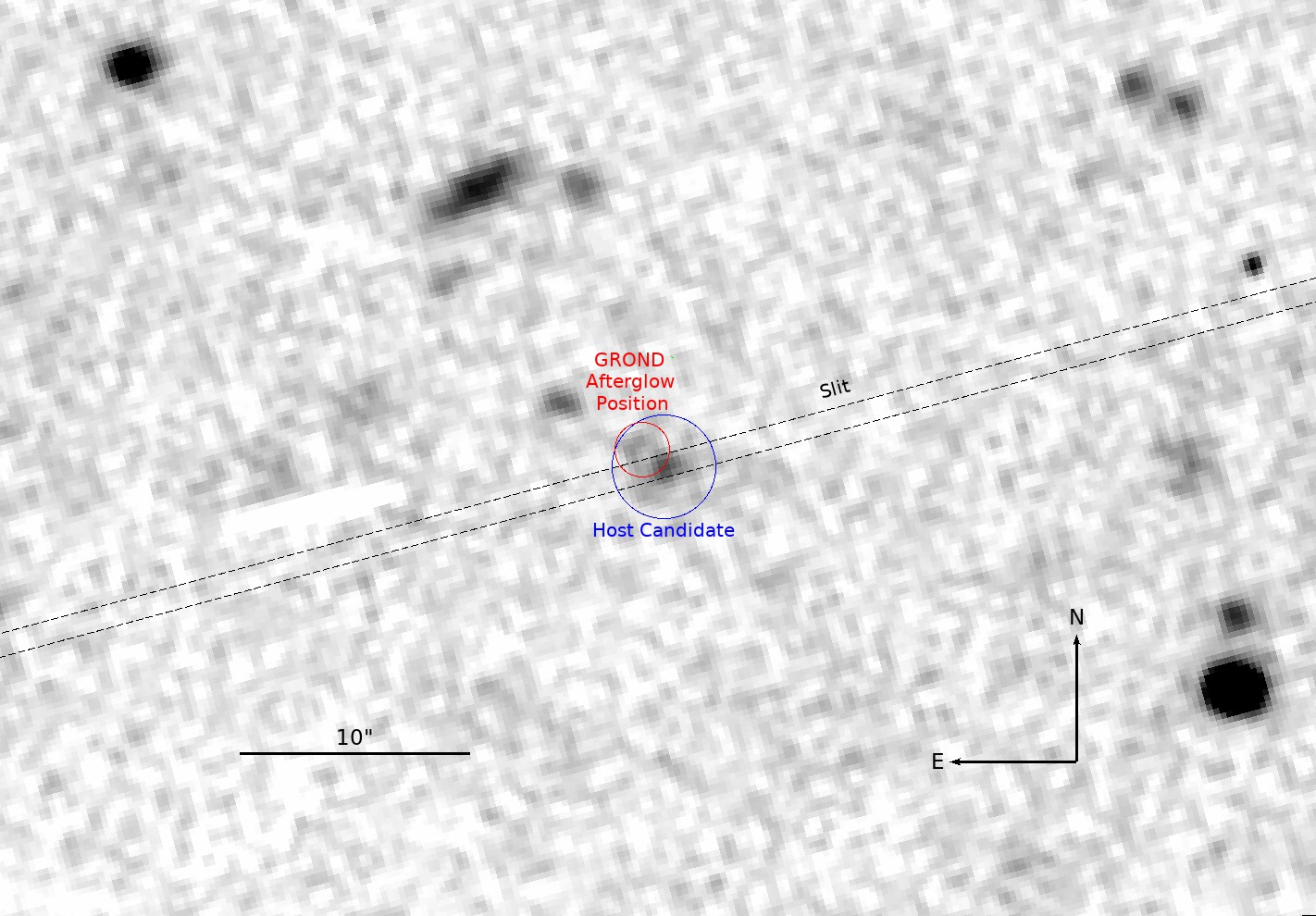
- GCN Circular #21067
Y. Yamada, A. Yoshida, T. Sakamoto, Y. Kawakubo, M. Moriyama,
A. Tezuka, S. Matsukawa (AGU), K. Yamaoka (Nagoya U), S. Nakahira (RIKEN),
I. Takahashi (IPMU), Y. Asaoka, S. Ozawa, S. Torii (Waseda U),
Y. Shimizu, T. Tamura (Kanagawa U), W. Ishizaki (ICRR), M. L. Cherry (LSU),
S. Ricciarini (U of Florence), A. V. Penacchioni, P. S. Marrocchesi (U of Siena)
and the CALET collaboration:
The short-duration GRB 170428A (Beardmore et al., GCN Circ. 21042; Tsvetkova
et al., GCN Circ. 21045) was detected the CALET Gamma-ray Burst Monitor (CGBM)
by the ground process pipeline at 09:13:42.36 on 28 April 2017 at 5.1 sigma which
is below the trigger threshold of the on-board trigger. The burst signal was seen
only by the SGM instrument.
Because there was no on-board trigger, no event data were stored for this
event. The continuous light curve data recorded in 0.125 s time resolution are
not fine enough to investigate the temporal structure and the duration of this event.
The light curve is available at
http://cgbm.calet.jp/cgbm_trigger/flight/1177405621/
The CALET data used in this analysis are provided by the Waseda
CALET Operation Center located at the Waseda University.
- GCN Circular #21942
S. B. Pandey (ARIES Nainital), Brajesh Kumar, G. C. Anupama (IIA Bangaluru)
and Kuntal Misra (ARIES Nainital) on behalf of a larger GRB collaboration
Short-duration GRB 170428A (Swift trigger =750298, Beardmore et al. GCN 21042)
was observed by the 3.6m Devasthal Optical Telescope (DOT) recently commissioned
by ARIES Nainital. The observations were carried out as a part of early science
run and characterizations. Observations were carried out just before twilight
using the 4Kx4K CCD optical imager, the first light instrument. Several R-band
exposures of 300-sec each were acquired in seeing conditions of around 1.1 arcsec
starting around UT 22:45:57 i.e. 13.5 hours after the burst.
In the stacked R-band frame of 3*300-sec, the candidate optical afterglow (Xu et al.
GCN 21048; Bolmer et al. GCN 21050) was clearly seen embedded within the host galaxy.
The photometry at the afterglow position measures a magnitude of 22.7+-0.2 mag
(calibrated with respect to nearby USNO stars). However, in the present data-set,
contamination with the probable host galaxy can not be ruled out in the estimated magnitude.
This is the first GRB afterglow observations with the 3.6m DOT and the full team of
staff members associated with the project are thankfully acknowledged to get this telescope
commissioned. We expect to contribute towards observations of time critical events in
near future assuming longitudinal advantage of Indian sub-continent using this facility.
The message may be cited.
- Redshift z= 0.453 +- 0.001 from host galaxy emission ([OII], [OIII])
W.-F. Fong et al. 2022, ApJ 940, 56
![]() Previous IAU Circulars
Previous IAU Circulars 



